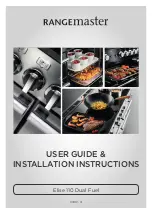
The oven
14
eter reaches the required temperature. Cover the meat
with aluminium foil and let it stand for about 15 min-
utes. This will make it easier to carve, and less meat
juices will be lost when carving.
Grilling
Size, shape, quantity, the degree of fat marbling, and
even the initial temperature of the meat all affect the
outcome and time of the grilling process. Fish, poultry,
veal and pork will not brown as much as the darker
meats such as beef and game. Vegetable oil and/or sea-
soning will improve the colour, but it also increases the
risk of surface burning.
For best results, avoid grilling food straight from
the refrigerator. Dry the surface of the meat, place it on
the oven shelf and season to taste. Place an oven dish,
ideally lined with foil, underneath the shelf to catch the
fat etc. which runs off. Pork chops, steaks and fish
should be grilled high up in the oven, while meats such
as thick spare ribs are better lower down.
Set the function control to
and the temperature
control to the temperature require (250ºC maximum).
Preheat the grill for 3 to 5 minutes. Keep an eye on the
food, and turn it at least once. Grilling for too long
makes food dry, dull, and possibly burnt as well. The
oven door should be closed when grilling.
Browning (swift start)
Excellent for browning au gratin dishes, toasted sand-
wiches, etc. You can also use this function to heat the
oven quickly to the set temperature. When the oven
has reached that temperature, you can then select
whichever function is required. It takes about 8 min-
utes to reach 200ºC. However, do not use this method
of rapid heating when baking biscuits or meringues.
Low temperature cooking,
max. 125°C.
Set the function control to
and the temperature
control to the required temperature (max. 125°C). The
low temperature method is ideal for food which can be
cooked slowly. When planning your cooking, remember
that it takes longer with this method before the food is
ready.
Joints of beef such as topside and sirloin retain their
natural juices best if roasted at 125°C. Consequently,
the meat does not dry out and lose as much weight as it
does at a higher temperature. Remember to use a meat
thermometer. Note! Meat should never be cooked at
temperatures below 100°C.
Slow cooking at a low temperature breaks down the
carbohydrates into sugar, a process known as ‘melt-










































